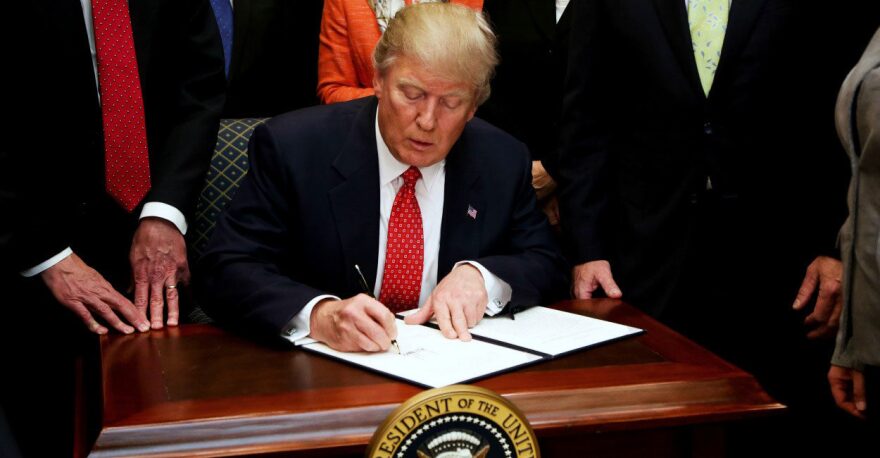The construction on Stevens Street on Rhinelander’s north side is nearly complete as heavy machinery rumbles by the auto dealerships that line the road.
But Tom Jerow didn’t come to look at a car or check up on the road work.
“I see a beautiful wetland with lots of diverse vegetation that are indicators of wetlands,” Jerow said.
Wedged between Rhinelander Toyota and the Aspirus Clinic is a low-lying wetland with tamaracks, cattails, and reeds.
Jerow is a retired regional water division leader with the Wisconsin DNR who now does work for Wisconsin’s Green Fire, a conservation group.
He’s concerned about the future of urban wetlands like this one.

More than half of Wisconsin’s wetlands are projected to lose their federal protection through an action by the Trump administration. We brought you that news in on The Stream earlier this month.
But the wetlands at risk aren’t only remote swamps and bogs far from communities. Wetlands in the middle of Northwoods cities could face issues, too.
Those urban wetlands do more than you might think.

In the 1930s and 1940s, said Jerow, the government actually paid people to fill in wetlands and build homes or businesses on properties like the one near the Toyota dealership.
Now, with the rise of wetland preservation, that’s more tightly regulated.
“There’s a tension between economic development and protecting wetlands. There should be,” Jerow said. “Wetlands are important, and so [is] economic development.”
On a landscape dominated by roads, parking lots, and other pavement, even small wetlands like this one play a critical urban role.
“This looks to me about the size of a football field,” Jerow said.
Like a giant sponge, a wetland of this size can store up to a million gallons of water, an important piece of urban flood control.
“If you get an intense rainfall, the runoff from parking lots and streets fills the wetland and it flattens that peak of that stormwater event so you don’t end up flooding other businesses or homes,” Jerow said.

Another wetland in a different part of Rhinelander, a wetland surrounding Spring Lake Road, holds even more water.
“It’s totally wooded, as you can see. There’s a lot of tamarack and some jack pine, which can tolerate some water,” Jerow said.
The wetland helps protect businesses on nearby Lincoln Street.
“If you want to survive a six-, seven-, eight-inch rainfall in a 24-hour period, it’s really important that we have these large wetland complexes,” Jerow said.
But he suspects this wetland is at risk.

Jerow thinks the Spring Lake Road wetland will likely lose federal protection under a Trump-administration change to the Waters of the United States rule that went into effect this year.
“My administration formally repealed the horrible, dangerous, anti-everything Waters of the United States rule,” Trump said in announcing the change. “I always say, the only thing that had going for it was the title.”
The Waters of the United States rule protects rivers, lakes, and many wetlands from pollution and damage under the Clean Water Act.
The Obama administration beefed it up before Obama left office.
“Then, the Trump administration threw all of that completely out the window and started over,” said Tom Bernthal, a retired DNR water and wetlands expert now contributing to Wisconsin’s Green Fire.
He helped create Wetlands By Design, a statewide service cataloguing wetlands by their watershed and best characteristics.

Bernthal found the same Wetlands By Design building blocks could be used to identify which wetlands were at risk under the new Trump administration rule.
“We found that between one-half and two-thirds of all wetlands in the state would not be considered regulated wetlands,” he said.
In other words, wetlands not adjacent to larger water bodies would no longer have federal protection. That’s 55 percent of the wetlands in Wisconsin, according to Bernthal and his collaborators.
That concerns Nick Miller, the Director of Science and Strategy for The Nature Conservancy’s Wisconsin Chapter.
“There’s part of an understanding that [wetlands are] part of Wisconsin’s system, that it’s not just the lakes and rivers,” he said.
Wisconsin is actually one of the more fortunate states when it comes to wetland protection, Miller said. State-level protections are layered onto federal protections.
“There’s an estimate that 27 states, over half of our states in the country, rely almost solely, or primarily, on federal protections,” he said.

But if Wisconsin loses federal protection on 55 percent of its wetlands, that’s still a major problem, said Tom Jerow in Rhinelander.
While the wetlands have state protection, he doesn’t think state DNR staff will be able to handle the new protection workload without federal help.

“[The DNR is] woefully understaffed. This is just going to transfer more work from the federal agents to the state wetlands specialists. Frankly, I don’t know how they’re going to do it,” Jerow said.
The Nature Conservancy projects northern Wisconsin will be more affected than other parts of the state, because more wetlands remain there.
One of those wetlands is the one on Spring Lake Road in Rhinelander, which Jerow thinks has now lost federal protection thanks to the Trump administration’s move.
“We cannot afford to continue to drain the swamp, so to speak, because they are so important to the quality of life to everybody in Wisconsin, that we value and maintain those wetlands,” he said.
The state has already lost half of its wetlands from pre-settlement days.
---
To access our earlier story on the role of rural wetlands in Wisconsin, click here.






